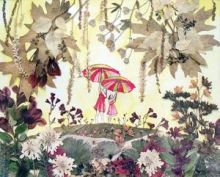Six hundred years ago in Japan samurai learned to “draw” pictures with petals. This art was called oshibana and gradually spread throughout the world. Plants from the Crimea, the Carpathian Mountains, and Zaporizhia “live” on patterns of the Ukrainian landscape designer, master of decorative and applied art Larysa Bulyhina. Private garden of Bulyhina became a great “creative lab” for her. The garden is spread out over 40 acres where you can watch day by day how plants are growing. “I am a professional landscape designer: I make designs for gardens and parks, I enjoy this beauty and when fall comes it is sad. I wanted to preserve the beauty of plants for as long as it was possible, but not in a form of a herbarium but in a full story, which would convey the depth of nature,” said Larysa Bulyhina.
Designer has been working in oshibana technique for almost ten years. This year she for the first time presented her art to the public. The first exhibition was held in Kharkiv, the second – in Alushta Museum of Regional Ethnography, and the third took place on November 8 in the Central Museum of Taurida in Simferopol, which featured 42 art works. The Day spoke with Ms. Bulyhina and learned the secrets of preserving fragile beauty of nature.
“Right from the beginning I have been an applied artist, but eventually I got fascinated with landscape design. Both of these techniques led me to oshibana, we call it flat floral design. Things that others can draw with a brush, I draw with petals. Such art work is in demand, people buy them. There are also those willing to learn this art. I am really happy about it and with a great pleasure I pass on my knowledge and skills: not only the grace of work is important, but also the knowledge of dendrology – not all plants are suitable for being dried, one should understand and know it.”
What qualities should a person that wants to master the art of oshibana possess?
“It is important to be able to observe: when you go to the forest, steppe, or on a meadow in May, you will see some plants, in midsummer you will see different plants, and fall is just fabulously rich! What we call a weed becomes red, orange, purple, and almost blue – and those are the plants that were rather unattractive in summer time. During a season you can each time find something new. In my garden I can watch the plants throughout the vegetative season: from one bush or flower I can pick completely different twigs and leaves during a year. That’s the trick. There are plants, whose leaves when dried become black, like velvet noble color. Generally I try to find rare color scheme for plants. By the way, all the art works at the exhibition have natural colors in them – there is not a drop of paint on them.”
What are the peculiarities of gathering material for oshibana?
“You can use virtually any plants that contain a minimal amount of moisture. Foliage from shrubs and trees, hard spring flowers, such as hellebore, are well suited for this. But primroses, tulips, and crocuses are not suitable. I dry plants in books, where I insert blotting paper or newspaper without printing. Then I put a press of 20 to 25 kilograms on a book and make sure that it’s airtight. Red, yellow, and blue elements remain bright for many years then. I have art works that were made more than nine years ago and they are still vivid. It is not recommended to dry plants with an iron: any processing with steam or heat makes plants more fragile and stains may appear. I have a separate storage room for gathered floral material.
“I once lived for a few weeks in Velyky Berezny raion in Zakarpattia: I was amazed with their meadows and underbrush. In the Crimea I was impressed with its steppe: great sage, grasses. In Fox Bay and in Rybache we hiked all hills. And when we climbed Ai-Petri I collected grass under the huge pines. In Zaporizhia I collect meadow material.”
Maryna Malhina, head of the Department of History at Central Museum of Taurida shared with us: “Today hand-made art works are in fashion because people feel that they are surrounded more and more with industrial things, which makes everyday life easier, but which cannot be made with one’s own hands. There are so many of such items that they lose their soul. Man instinctively strive for hand-made things, often wants to get involved in the creative process.”







